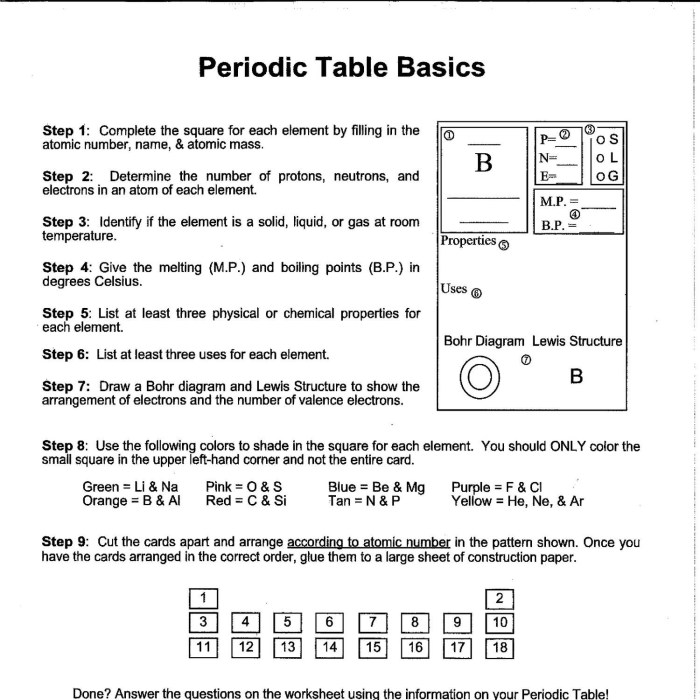Introducing the intro to the periodic table worksheet, an invaluable resource for chemistry students seeking to unravel the mysteries of the periodic table. This worksheet provides a comprehensive overview of the periodic table, empowering students to decipher the secrets of chemical elements and their properties.
The periodic table, a cornerstone of chemistry, serves as a roadmap to understanding the behavior of elements. This worksheet guides students through the intricacies of the periodic table, enabling them to identify elements, comprehend their properties, and unravel the patterns that govern their interactions.
1. Introduction
The periodic table is a tabular arrangement of chemical elements, organized on the basis of their atomic number, electron configurations, and recurring chemical properties. It is a fundamental tool in chemistry, providing a systematic way to study the properties and behavior of elements.
2. Understanding the Periodic Table
2.1. Visual Representation
The periodic table is typically arranged in 18 vertical columns, called groups, and 7 horizontal rows, called periods. Elements are arranged in order of increasing atomic number, which is the number of protons in the nucleus of an atom.
2.2. Organization of Elements
Elements are organized in the periodic table based on their atomic number, atomic mass, and chemical properties. Elements with similar chemical properties are grouped together in the same column, or group. Elements in the same period have the same number of electron shells.
2.3. Periodic Trends
The periodic table shows periodic trends in atomic radius, electronegativity, and ionization energy. Atomic radius decreases across a period and increases down a group. Electronegativity increases across a period and decreases down a group. Ionization energy increases across a period and decreases down a group.
3. Groups and Periods: Intro To The Periodic Table Worksheet

3.1. Groups
The groups in the periodic table are numbered 1-18 from left to right. The group number of an element indicates the number of valence electrons in its outermost electron shell. Elements in the same group have similar chemical properties because they have the same number of valence electrons.
3.2. Periods
The periods in the periodic table are numbered 1-7 from top to bottom. The period number of an element indicates the number of electron shells in its atom. Elements in the same period have the same number of electron shells.
4. Properties and Applications
4.1. Properties of Selected Elements, Intro to the periodic table worksheet
| Element | Atomic Number | Atomic Mass | Electron Configuration | Common Oxidation States |
|---|---|---|---|---|
| Hydrogen | 1 | 1.008 | 1s1 | +1,
|
| Helium | 2 | 4.0026 | 1s2 | 0 |
| Lithium | 3 | 6.941 | 1s22s 1 | +1 |
| Beryllium | 4 | 9.0122 | 1s22s 2 | +2 |
| Boron | 5 | 10.811 | 1s22s 22p 1 | +3 |
4.2. Applications of Elements
The periodic table is used in a wide variety of applications, including:
- Predicting the chemical properties of new elements
- Understanding the behavior of elements in chemical reactions
- Developing new materials and technologies
5. Practice and Review
5.1. Interactive Exercises
Interactive exercises can be used to help students practice identifying elements and their properties based on their position on the periodic table. These exercises can be found online or in textbooks.
5.2. Review Questions
Review questions can be used to test students’ understanding of the concepts covered in the worksheet. These questions can be found at the end of the worksheet or in a separate review guide.
Answers to Common Questions
What is the purpose of the intro to the periodic table worksheet?
The intro to the periodic table worksheet is designed to provide students with a comprehensive understanding of the periodic table, its organization, and the properties of elements.
How can I use the intro to the periodic table worksheet?
The worksheet can be used as a self-study guide, a classroom resource, or a supplement to textbooks. It includes interactive exercises, review questions, and real-world examples to enhance learning.
What are the benefits of using the intro to the periodic table worksheet?
The worksheet helps students develop a strong foundation in the periodic table, enabling them to identify elements, predict their properties, and understand chemical reactions.